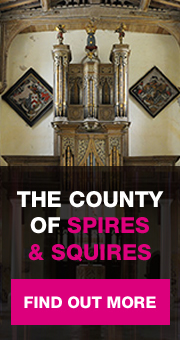The tall Saxon tower is the oldest part of this church, which was rebuilt in the 16th century and then again, rather enthusiastically, in the mid 19th century. The latter was undertaken by the Revd. Crawley, an early convert to the Oxford Movement. The Crawleys came from Flaxley Abbey in the Forest of Dean but by the 18th century were well settled, ecclesiastically, in Northamptonshire. A quick look at the incumbent’s board at St Michaels, shows you that a Crawley was minister here from 1789 until 1921, perhaps a record. One of their cousins, Blanche, married William Gibbs of Tyntesfield, who bankrolled the Oxford Movement and largely paid for Keble College. At Stowe the gothic treatment is somewhat stark in comparison but the latest Church of England “essentials” are to be found – a carved font by the door, encaustic tiles, stained glass, an organ, and an elaborate communion rail. The monuments all predate this period and one wonders what the Revd Crawley made of the sumptuous tomb of Lady Elizabeth lying beside his new altar. Monuments One of the most impressive early baroque monuments in England is to be found here. To the right of the altar lies, to give her her full names, Lady Elizabeth Neville, Lady Danvers and subsequently Lady Carey. She was the daughter of Lord Latimer and thus part of the great Neville family who were one of the few noble families to survive the Wars of the Roses and prosper under the Tudors (although her father was the last Lord Latimer and she and her sisters were his rich co-heiresses). Lady Elizabeth was one of four daughters. Her sisters were Catherine, Countess of Northumberland, and Dorothy, Countess of Exeter, both of whom were buried in Westminster Abbey, and Lucy, Lady Cornwallis. Their father, Lord Latimer, had married Lady Lucy Somerset, daughter of the Earl of Worcester, the descendant of John of Gaunt. Her splendid tomb, now destroyed, was in Hackney Parish Church “of alabaster, sett over the place with pictures of myself and my fower daughters with arms of the late Lord Latimer, their father, and their several husbands, to be sette, cutte, and graven – cost 500 marks.” The paternal grandfather of these four daughters, was John Neville, Lord Latimer, husband of Catherine Parr, who on his death married Henry VIII. This is not the only royal connection as Lady Elizabeth’s second husband was Sir Edmund Carey, the son of Lord Hundsen, Elizabeth I’s only maternal cousin. Whilst kept apart from politics he was the recipient of many favours from the Queen, not least Kenilworth Castle after Lord Leicester’s death. Not surprisingly, the tomb of such a rich and well connected person is both splendid and innovative. It is one of the very first effigies where the deceased is accurately portrayed. In this case as a remarkable old lady. She lies dressed in a fine ermine robe open to reveal a delicately embroidered bodice. Her head is partly wrapped in a cloth but rests on an equally fine pillow. She wears exquisite tiny shoes, one of which is supported by her heraldic griffin. The image is both one of great realism and of great dignity. Like her near contemporary, John Donne, she modelled for the sculptor long before her death. He was the most important English sculptor of his day, Nicholas Stone (1587-1647), friend of Rubens, Van Dyck and Inigo Jones. He executed the effigy between 1617 and 1620 at a cost of £220. The white marble figure lies on a black and white tomb chest which contains many references to Lady Elizabeth’s children. Her eldest son, Henry Danvers, was created Lord Danby and is well known through the spectacular full length portrait by Van Dyck, now in the collection of the Hermitage Museum. It was for him that Stone created the magnificent gates for the botanical gardens in Oxford between 1632-3 shortly after his mother’s tomb had been installed here. It may seem superfluous to mention other memorials but on the other side of the chancel lies the impressively long Sir Gerald de L’Isle (1304-1360): a gigantic knight in Purbeck marble. His costume reflects his military service under Edward III in the Scottish wars, 1333-5, and then in France where he fought at the Battle of Crecy. He inherited the family estates at Stowe in 1347 and made a pilgrimage to Rome in the holy year of 1350. He died a decade later but not before marrying the heiress to Basing Castle in Hampshire, fighting the French one more and entering Parliament. His life was as large as his memorial. Beyond lies another huge memorial, put up to celebrate not a burial spot, but charitable achievements. When Doctor Thomas Turner (1645-1714) died, he left a considerable amount of money to buy land at Stowe, the income derived to be used for charitable purposes. Here, as at Corpus Christi College Chapel, where he was President since 1688 he is fulsomely acknowledged. The vast wall tablet is by Thomas Stayner, bounded on either side by full length figures, Dr Thomas himself standing on a terrestrial globe to the left and Faith stand on a celestial one to the right. A baldachino hovers over the exhaustively inscribed tablet in the centre. Stayner, (c. 1668-1731) was well established by the time he attended to this commission, having indeed been Master of the Masons Company in 1709. That said, this is his most ambitious work. He would have been made in his mason’s yard at Bow Bridge in Essex before being transported by cart to this remote part of the county. A coda: at the back of the church is a fine local work. The memorial to John Daye (d. 1767), Comptroller of the General Foreign Post Office. It was erected here by his daughters who commissioned John Middleton of Towcester (1718-1801) to carry out the work.
Please refer to the Glossary for any terms in the text that you are unfamiliar with.







